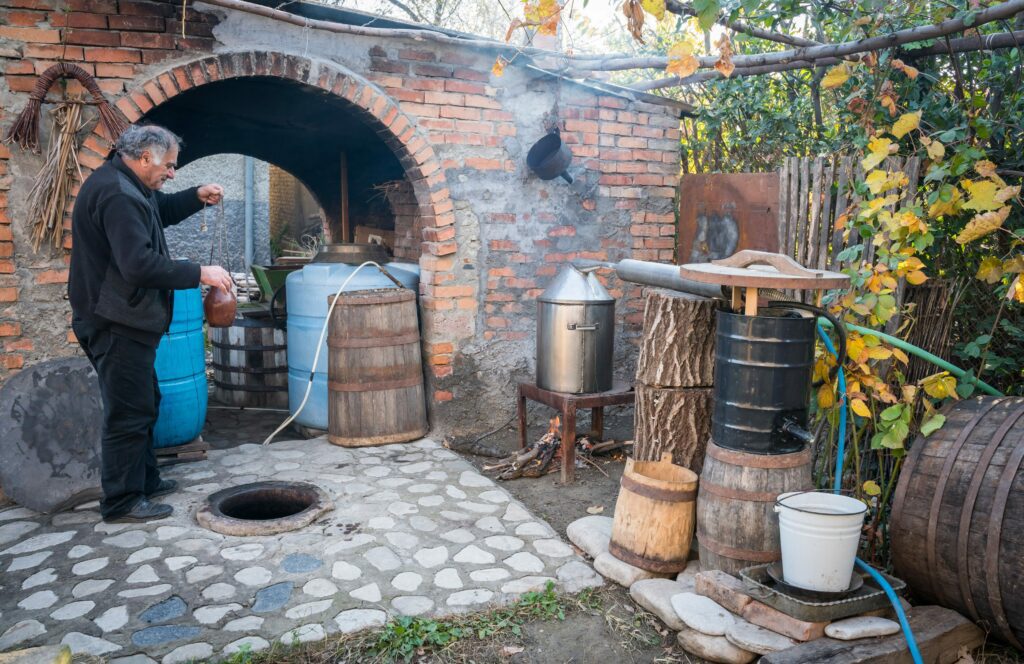Georgian Chacha, is a distinctive Georgian alcoholic beverage that is beloved by locals but honestly makes many foreigners groan (just a little) when it’s brought to the table. This strong (I mean STRONG, often over 70% ABV) spirit is a by-product of the wine-making process and its rich history and unique production methods have been intertwined in Georgian culture for over 1000 years.
It’s so important to Georgia that it was made a PGI (Protected Georgraphical Indication) product, so you can only put the word “Chacha” on the bottle, if it was made in Georgia from Georgian grapes.
In this post, we’re going to discuss the origins of Georgian Chacha, how it’s made, some of its health benefits, and uncover the different flavours that make it a favourite among locals and a must-try for visitors to Georgia.

What is Georgian Chacha?
Definition and Origins
Georgian Chacha, sometimes known as “Georgian brandy” or “Georgian Grappa”, is a traditional grape-based pomace brandy that is widely consumed and celebrated in Georgia. It is often compared to similar drinks like Italian grappa or Ouzo, as it is also made from distillation of the must (pomace) that remains after the winemaking process.
The roots of Georgian Chacha can be traced back over 1000 years and is deeply intertwined with the country’s winemaking traditions.
Chacha is crafted by distilling the fermented grape skins, seeds, and stems left over after the winemaking process. This allows Georgian winemakers to maximize the use of their grape harvest, reducing waste and creating a versatile and flavoursome spirit.
FYI, the term for the leftover skins, seeds, and stems (which are also sometimes used in winemaking, but not always) is also referred to as “Chacha” in Georgia (not pomace) as well as the final drink after distillation – this can sometimes be a little confusing for visitors.

Distillation Process – How to Make Georgian Chacha
The distillation process plays a crucial role in refining the leftover skins and seeds into Georgian Chacha or (also sometimes called “Georgian Vodka” even though the production method is different – but its a stong transparent spirit, so looks similar).
Here’s a breakdown of the distillation process:
- Fermentation: After the grapes are pressed for winemaking, the resulting pomace (the “Chacha” in Georgian) is collected for fermentation. The pomace/must is placed in large fermentation vessels, where it undergoes a natural fermentation process. Often in qvevris (Georgian amphora), but steel tanks, wood vats, glass containers etc. may also be used. The frementaion process can take anywhere from 7 days to a few weeks, allowing the fruit sugars to convert into alcohol, and wine to be the result.
- Pot Still Distillation: Once fermentation is complete, the pomace is transferred to copper pot stills for distillation. It’s worth noting that the pomace is not always removed directly after fermentation, its common with Georgian amber wines, for example, to leave the wine on the pomace for up to 6 months, sometimes more.
The stills used in Chacha production are often small, homemade and crafted with centuries-old techniques. We’ve seen everything from beautifully handcrafted stills to basically a drum barrel with some pipes used to make Chacha – it’s amazing what you’ll find winemakers and locals using! Anyway, the pomace is carefully heated, and the alcohol vapors are collected and condensed, resulting in a higher proof spirit. We’re talking 40% and higher. I think the highest we’ve ever tried is 74% – woof! - Fractional Distillation: Some producers opt for a second distillation, known as fractional distillation, to further refine the Chacha. The spirit is distilled multiple times, each time removing impurities and enhancing the desired characteristics. This meticulous process allows for greater control over the final product’s quality and flavor profile.
- Aging (Optional): While Chacha is often consumed young and unaged, some variations are aged in oak barrels or other wooden vessels (my personal favourite style of Chacha). Aging adds additional complexity and smoothness to the Chacha, adding flavours and aromas almost like a nice scotch or whiskey. However, it’s worth mentioning that the aging process is not as extensive as you would find with traditional brandy or Cognac, Georgians tend to opt for shorter maturation periods ranging from a few months to a couple of years. But there are certainly some producers we’ve met that are working on aging their Chacha for longer – and I look forward to trying it when it is ready!

If you’re looking for a more detailed explanation of the Georigan Chacha making process, this article by WIPO (World Intellectual Property Organization) is an interesting and comprehensive read.
After all of this, the final product as a drink can be enjoyed neat (usually as a shot), or used as a base for some tasty cocktails.

Georgian Chacha Cultural Significance
Chacha holds a special place in Georgian culture and is considered the country’s national spirit. It plays a significant role in various social and cultural events, including weddings, celebrations, and traditional feasts called supras. The offering and sharing of Chacha symbolizes the hospitality and warm welcome of the Georgian people.
Chacha is also deeply connected to Georgia’s winemaking traditions. The grape varieties used in Chacha production reflect the diverse and unique terroir of the country. Different regions in Georgia produce Chacha using their own grape varieties, resulting in a wide range of flavours and aromas that showcase the country’s vinicultural diversity. Aside from grapes many other fruits and herbs can also be used to make Chacha too, including figs, quince, tarragon, apples, pears….the list goes on! But the main fruit that is used is of course Georgia’s beloved grapes.
Families come together for the “Zaodoba” home festival, where they distil the Chacha and celebrate together. This is an event it is occasionally possible to attend as a foreigner, either as part of a tour or if you happen to have Georgian friends who make wine and can get an invite to their home. Artificial/simulation versions of this can also be booked as a tour or at some of the larger wineries and wine hotels, provided you have a larger group wanting to attend.
–> Our tour company Eat This! Tours offer a small number of tours each year where you can join the families and make chacha and churchkhela (Georgian national dessert). Find out more about our Chacha tour here

Varieties of Georgian Chacha
As mentioned before, the varieties of traditional Chacha that can be found differs based on the grape variety it’s produced from and where the grapes are grown. The higher the quality of the grapes, typically, the higher the quality of the Chacha.
Grape Varieties
Georgian Chacha is made from an assortment of grape varieties, each chosen for its specific qualities and flavours. The most commonly used grapes for Chacha production are:
- Rkatsiteli: One of the oldest grape varieties in the world, Rkatsiteli is the most widely planted grape in Georgia.
- Saperavi: A “teinturier” grape that produces dark red fresh juice instead of pale juice, leading to almost black wines and interesting Chacha’s
- Kakhuri Mtsvane: The Kakhuri (Kakhetian) variety is the most planted, but it has cousins in Kartli, Racha, Meskheti.
But honesty….you can make Chacha from any grapes (or fruit) and many people in the villages just use what they have.
Serving and Pairing Georgian Chacha
Ideal Serving Temperature
Ok, so there’s no standard serving temperature for your run-of-the-mill family Chacha. Room or marani (Georgian wine cellar) temperature (14 Degrees Celsius) is how its typically served. If you are partaking in a fancier bottle of Chacha you may want to chill the bottle for an hour before you drink up. I’ve never seen an average Georgian serve it on ice, but whatever you want to do is up to you! If served in a cocktail (which is a new trend since ~2016), then ice is certainly added.
If you are attending the Zaodoba (Chacha distillation festival) then it is typical to taste the new Chacha hot, straight from the distillation pipe!

Food Pairings
The main food that is paired with Chacha is khinkali. Usually at restaurants, you’ll see tables of men with large plates literally overflowing with khinkali and a bottle of Chacha either on the table or in an ice bucket beside them. And I have to say, taking a shot of Chacha before slurping up the steamy juices and meat packed inside a piece of khinkali does enhance the flavour a bit….but maybe not worth the hangover the next day. That choice I leave entirely up to you! And if Georgian’s tell you their all-natural Chacha won’t give you a hangover, this is almost always untrue, if you drink too much of it!
Chacha is also something that will be served towards the end of a supra or wine pairing, so it also goes nicely with bbq pork (mtsvadi), dried fruits and nuts, and local Georgian cheeses like sulguni or guda.
What Is The Health Benefits of Georgian Chacha?
Besides being enjoyed as a drink, many local Georgians believe Chacha also possesses several health benefits.
Antioxidant Properties
One of the notable health benefits of Georgian Chacha is its antioxidant properties.
The high concentration of polyphenols found in Georgian Chacha makes it a potent source of antioxidants. Polyphenols can help with digestion, give your brain a boost (once you sober up!? 74%, lol.), and help keep your blood sugar in check. Plus, they’re like the little internal bodyguards against blood clots, heart issues, and even some types of cancer.
Research has suggested that consuming moderate amounts of Georgian Chacha, in conjunction with a balanced diet rich in other antioxidant-rich foods, may contribute to overall health and well-being. However, excessive consumption can obviously have detrimental effects on your health, so moderation is key! And maybe stick to the 50% stuff, rather than the 74%.
Digestive Benefits
In addition to its antioxidant properties, Georgian Chacha is also known for its digestive benefits. Traditionally, Chacha has been used as a digestive aid, particularly after a supra (Georgian feast). When you’re so insanely stuffed from eating all of the incredible local Georgian cuisine, Chacha can actually help with digestion and gastrointestinal health.

Our Top Must Try Chacha’s in Georgia
When you visit Georgia you’ll find that basically anyone that makes wine – also makes chacha, but finding a good chacha to try can be a tricky task for a visitor. Lucky for you we’ve been to over 200+ wineries and numerous wine festivals and tried a few chachas in our time living here.
Here’s the TOP 3 Chacha’s we recommend:
- Mukhiguli 1778
- Bua Wines
- Tedo’s Marani – try their chacha aged in mulberry wood.

Georgian Chacha is a unique and flavorful spirit that holds a special place in Georgian culture and tradition. Its distinct taste and versatility make it a favourite among locals and an “interesting” discovery for visitors. Whether enjoyed neat, used as a base for cocktails, or paired with traditional Georgian cuisine, Chacha offers an authentic, and memorable drinking experience in Georgia.
While I joke about foreigners not being the biggest fans of Chacha (it’s just sooo lethal) If you haven’t tried Georgian Chacha yet, I highly recommend seeking it out and experiencing this unique spirit either in your hometown or why not hop a flight and come visit us in Georgia, and we’ll all toast to your initiation to this traditional Georgian spirit.
In Georgia Chacha is everywhere, so it won’t be hard to find. It’s a bit like Beetlejuice – if you say “Chacha” out loud in Georgia, it will probably appear, even if you don’t want it to, and you only need to say it once, rather than 3 times, to find the bottle is already being poured into shot glasses!
Gaumojos! (Cheers!)




